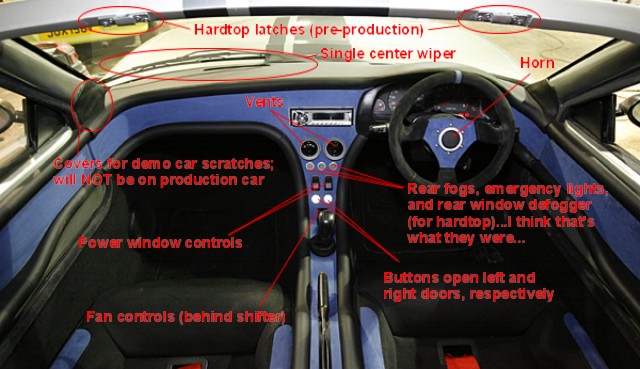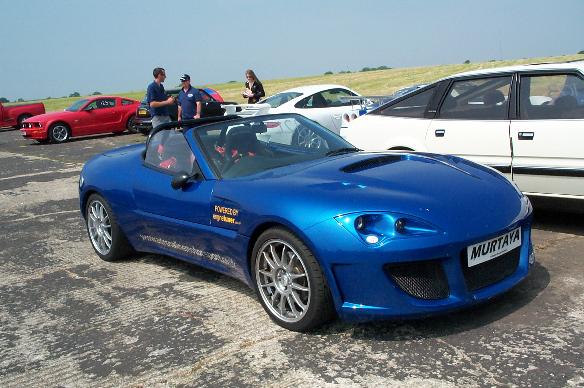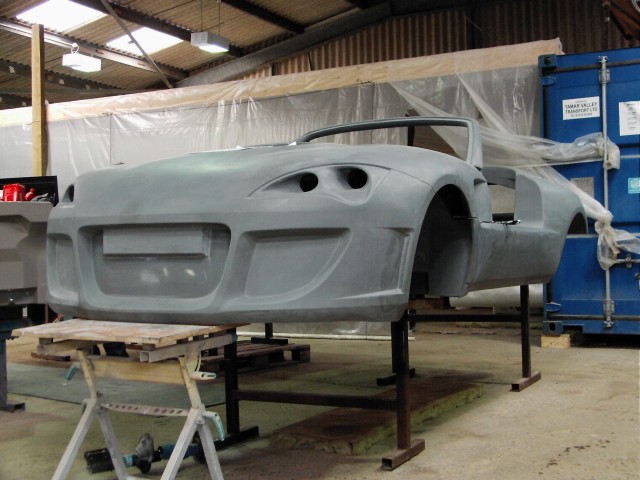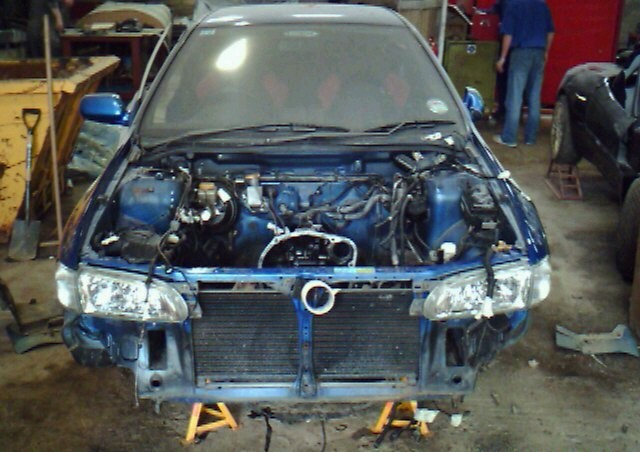So there I was, on what was no doubt one of the longest
and most expensive test drives ever. Would it be worth it? A few times I
thought how easy it would have been to just go to the local Chevy dealer and
try a new Corvette. But the car I was seeing was something different - very
different. It had a blend of everything I had been wanting in a car:
lightweight, AWD, torque, turbo-fed power, and a sexy, slick sports car body.
I had waited for a long time to find such a car, and I was on my way to
Cornwall, England, to see it in person for the first time, along with the guys
who created it.
Unfortunately, my companion (my father) and I were having
a little trouble that day trying to find Trebudannon Farm, the place where
Adrenaline Motorsport (AMS) - the company put together to assemble this car - was
based. We had been doing well with the directions in England so far, having
found the rental car place as well as our hotels for the previous nights.
However, AMS was proving to be a bit more difficult to find.
In a very un-manly fashion, we decided to stop at a gas
station to ask if they knew the whereabouts of AMS. The ladies only showed a
slight knowledge of Trebudannon Farm, and then continued with the directions
that only the English can give and only the English can understand, in the
form of a succession of right-and-left directions delivered at roughly 2453
words a minute. Once again, my dad and I nodded our heads, thanked them, and
walked out, still lost.
And then he pulled up. A blue STi R-type pulled into the
gas station. We had not seen many of these during our time in England, and I
had a feeling that this one was special. Indeed, it had a Powered by
Adrenaline Motorsport label on the upper part of the windshield. As
the tall driver got out, I instantly recognized him - if but only from photos I
had scene on the Internet - as Neil Yates, Managing Director of Adrenaline
Motorsport.
"You wouldn't happen to be Neil Yates, would you?" I
asked, approaching him excitedly.
"That would be me." He replied, if not a bit baffled as
to who this Yank was walking towards him. I quickly introduced myself and my
father. Neil was just going to the gas station to grab some tea (while
waiting for us to show up, no doubt). He was happy to show us to the farm,
and did so. As we followed him through the back roads, my father noted that
we would have never been able to find it without him. I agreed. Five minutes
of more driving, my father said we REALLY wouldn't have been able to find the
place without him. Again, I agreed. It was like somebody was looking out for
us, having put Neil at that lone gas station the same time as we were.
We finally pulled into the farm. I recognized "Scooby",
the resident dog, from the photos that Mark Sansby had taken during his visit
to AMS. Likewise, a recognizable yellow Minari sat in front of the AMS
office, which was inside the first barn house. Neil introduced me to many of
the talents at AMS, including Tom, Tim, and Andy (PR for AMS), who had come to
work that Saturday to meet me despite having a recent loss in the family.
This had meant a lot to me, and I was sure to let them know.
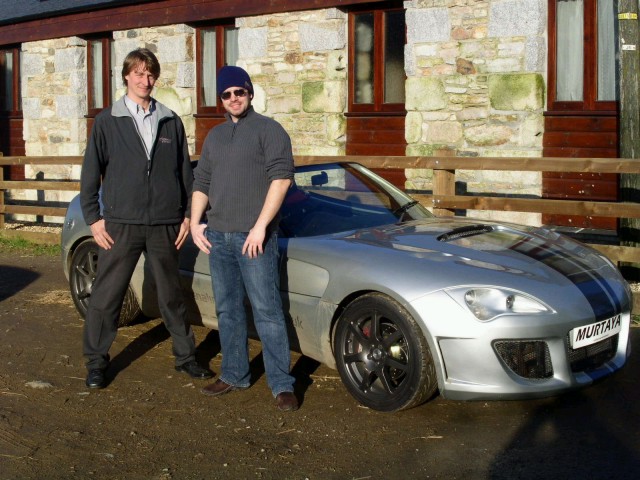
Neil and me in front of the demo Murtaya
As I started walking into the office, Neil mentioned that
I had come all this way and probably couldn't wait to see the car...I agreed,
but missed what he was trying to tell me. It was then that I noticed that he
was signaling me to a passage way beside the office. I followed it, finding
that it led to the assembly area in a bigger barn house...
And this is when I first noticed what a good showman Neil
was. He had positioned the demo car to be facing me as I emerged from that
passage way. There it was, glimmering and shining cleanly in the bright
light, almost smiling at me. Wow. That right there had made the entire trip
worth it. There it was: the Murtaya (missed picture opportunity #1...I was
overcome with awe and the last thing I was thinking about was the camera).
As I realized on the plane trip back, I had forgotten to
ask Neil about where the name Murtaya came from (among many other
things...the visit was so exciting and went so fast that I had indeed forgotten
to do many things, like taking all the pictures I wanted). Maybe one of these
days he'll enlighten us. But regardless, that was the name of this WRX/STi
powertrain-based, lightweight, monocoque sports car that had caught my eye in
the auto news nearly a year ago, which had originally been codenamed the
AMS1.
I looked over its muscular design and orbited around it
till I was next to the small driver's door, looking inside. The blue Alcantara interior looked great and I was excited to see the door function as
Mark Sansby had reported months ago. Sure enough, Neil took out a key
fob and hit a button, unlocking and releasing the door. I opened it and
climbed over the large, high sill. This was the first time I witnessed
one of the most striking features of the Murtaya: its rigidity.
I had long wondered if this glass-reinforced fiber body would be rigid,
especially in convertible form. Well, I have often heard auto magazine
car reviewers describe some cars as "being so rigid that they feel like they
had been carved out of a single piece of steel". That's the feeling I
got as I climbed into this car, except multiplied three times. I wished
that those reviewers were able to sit in this Murtaya and realize what a truly
rigid car felt like. The rigidity of the car would also show up in the
drive.
The interior was great. Granted, being a hand made, "kit
car", I had originally been expecting a very simple, cheap interior. However,
the Alcantara was done very well, and the layout of the dash was such that it
flowed up from the center console, out around the driver and passenger, and
finally along the inner doors in one continual shape. There were two
adjustable vents shooting out from the center (heat is standard and AC is an
option on the Murtaya), and underneath those were three buttons for such
things as the rear foglights and emergency flashers (in production cars, they
will be multi-stage buttons with a variable light luminosity showing what
stage is currently selected). Beneath those are two black switches that
control the powered windows (which, despite the very short doors, pull the
windows down quite far). Finally, under those switches lie two more round
buttons. These perform the same function as the buttons on Neil's key fob:
unlock and release the doors on their respective sides. Very cool. Finally,
at the bottom lies a black switch for the heater.
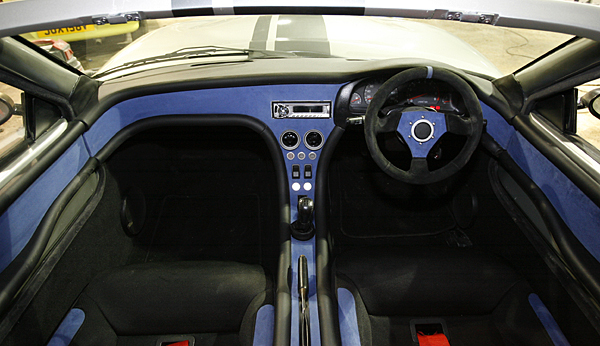
The Murtaya's interior
The seats were race seats with five-point harnesses.
They held you in place, yet I didn't feel like I was laying down in a coffin
(as I did when I was in a C5 Vette). Neil said that the seats could be
lowered if the racing harness was replaced with a standard tension belt, but I
told him it felt fine and was a great seating position, even for a daily
driver.
We fired the car up, and the 2.0L flat four came to
life. The large exhausts gave a very low, mean sound with the distinctive
boxer rumble found on most horizontally-opposed engines. However, the regular
person would likely be surprised that just a four cylinder was under the large
clamshell hood.
Speaking of which, Tom Taylor (the tall engineer of AMS)
raised up the clamshell hood to show us the heart of the Murtaya. This car
had obviously been run and run hard (like a good demo car) judging by the
dirty engine; this is what I like to see. However, it was more than just a
demo car; in many ways, it was still somewhat of a development mule. For
example, the frame that holds the suspension has been adjusted many times to
find the optimal geometry. Now that they've found it, the production frames
will be designed from the start with the angles and in return will be a lot
cleaner looking. Similarly, there were covered holes in the doors where the
temporary side view mirrors had originally been attached...Neil assured me those
would disappear soon when the car got a new look and finish in the coming
weeks...
Before we went out in the car, Neil showed us around the
facility. He showed us the sealed off room where the GRP molds are used to
create the stiff body as well as the clamshell hood, boot lid, and doors. In
fact, my tub was being assembled right there (missed picture opportunity #2).
Neil showed us the designs for the Murtaya, how the GRP
is laid out and assembled, and many of the little details that showed how much
thought was put into the design of the Murtaya. It was evident of the amount
of thought put into it. Stronger areas where the front frame connects to the
tub, crash areas, and little indents to perfectly fit things like transmission
mounts, etc. In fact, the main designer of the Murtaya, Daniel Muir, has done
work for Lotus (first generation Elise, for example) and Aston Martin.
Currently, he is working on a car design for what will most likely be a very
important and famous car, if its predecessor is any example. Dan used his
experience and computers to design this car for both performance and
usability; it was designed to comfortably fit a large percentage (95 percent,
to be exact) of the European population. In fact, it does so; both Neil and
Tom are over six foot and obviously fit. Moreover, since the Murtaya is such
a low-volume car, it can more or less be fitted to each customer. For
example, we found that an optimum position of the shifter for me would be
about an inch forward of the position in the demo car.
It should be noted that while it looks like the Murtaya
is an evolved form of the Minari, it in fact only shares the same windshield
with that car. The Murtaya is actually a resurrection and evolution of the
Feroce Delfino, which AMS got the tooling to but - after finding many issues
with the design - decided to redo it properly. And thus the Murtaya was born
(again, I still don't know the origins of the name, but it must be better than
the Ferocious Dolphin, right?).
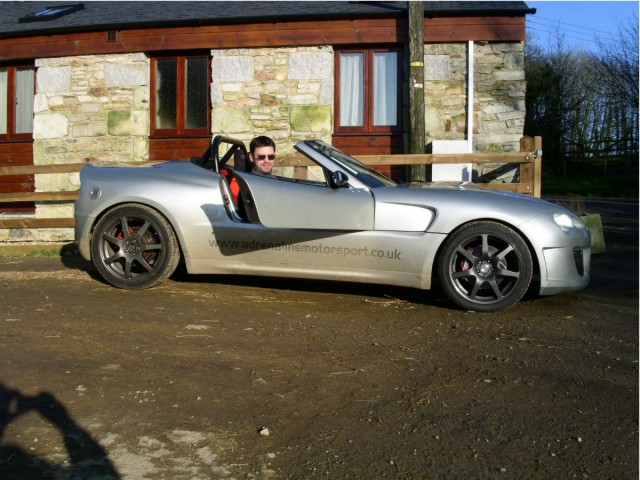
Me in the Murtaya
After lunch, it was drive time. I buckled myself into
the passenger seat and the five-point. Neil started it up and took us out to
the road. Since he had last taken it out, there had been several changes. A
longer-geared five-speed transmission replaced the shorter ratio box that had
originally been in it. Also, the brakes were new (and needed to be bedded),
and a new combination of suspension springs were being tested.
Neil began with the brake-bedding process. Again, I
noticed how rigid that car was. It felt like we were in a tank; it was hard
to believe that the car only weighed 2000 pounds. The rearview mirror didn't
even vibrate (even on the spotty, cratered Cornwall roads), and remember: this
car had no top.
We got onto an open road, and after some quick test swerving
(showing no body roll), Neil opened it up. The exhaust roared and we took
off, taking corners flat and fast. The speedometer went up very fast and the
pull at full boast was very impressive. Maybe I was taken in by the moment,
but the loud blow-off valve easily noticeable in the YouTube videos went
unnoticed by me, as did the air intake. There were just a lot of Gs: forward
Gs before the corners, sideway Gs in the corner, and rearward Gs exiting the
corners and as we effortlessly passed cars. Before I knew it, it was my turn
to take the driver's seat.
I got in, repeated the buckling process of the
five-point, and got adjusted to the car. For all you tall people out there,
you shouldn't have much problem fitting in this car. In fact, with the
combination of my 5'10" stature and close-to-the-steering-wheel position
preference, I found myself at the extreme front of the driver's seat
adjustment.
The next thing I noticed was how stiff everything was. Now this
time I wasn't referring to just the rigidity of the car. The steering effort,
clutch pedal, and shifter all had a stiffer feeling than I was expecting. At
first I didn't know if I liked this, but when I realized I was in a
high-performance car rather than a standard Impreza, and when I spent a
little time with them, it wasn't really an issue.
For example, the steering (of which some of the natural
steering boost from the Impreza rack was removed to give it a more direct
feeling with the road) lightened up as soon as you started moving and then
continued to feel direct, especially the closer to lock you got it.
The clutch stiffness (from a heavier-duty clutch) went
out-of-mind before you knew it. At the same time, it wasn't an on-off switch,
as I had feared; in fact, I could easily start moving the car without using
the throttle if I so desired.
On a side note, this car revved fast...much faster than
any other turbo charged Imprezas I've been in (including modified 2.5L US
turbo STis). This was because along with a heavier duty clutch, the Murtaya
also comes standard with larger brakes and a lighter flywheel, the latter of
which allowed quicker revving. This was an absolute delight when it came to
double clutching, as there was no wait time for the revs to get up to the
desired RPM (of course I was coming straight from a 1.4L Corsa, which
basically had to be floored to get any revs out of). On the other hand, the
brake and gas pedal were a bit too far apart for me to do any heel-toeing
(which, in my case, I use the sides of my feet). This was only for me,
though, and heel-toeing was not a problem for Neil and many of the other
drivers, and in fact could be easily fixed for me in my car.
The only other issue I had was with the shifter: it
seemed a bit stiffer than the WRX 5-speeds and STi 6-speeds I had driven. Or
perhaps it was because I was handling it with my left hand, which had only
been driving stick for a day (being from the left-side-drive of the states).
But either way, it took some getting used to. Considering the fact that every
Murtaya will be different and sourced from different cars, this might just be
a characteristic of this car. The gear spacing, despite being longer and the
current, peaky nature of the 2.0L engine, was not bad, though I still noticed
places where turbo lag was present when not in the optimum gear.
I thoroughly enjoyed driving the demo car, but it should
be known that I am usually hesitant to go anywhere close to 10/10ths in cars I
am not familiar with...not to mention I was on the right side of the car
shifting left handed on unfamiliar roads. So (unlike a true car reviewer) I
didn't open it up often, take corners too hard, or get on the brakes (the
latter especially because these were still being bedded). But if I was
uncomfortable, it wasn't because of the car: it was VERY easy to drive (almost
too much so, in some ways; ask Neil about some of his past test drives).
Traction was absolute, even during hard downshifts into the meat of the power
band. There was no tire spinning - just the wheels grabbing the pavement and
thrusting you forward - even on the less-than-ideal Cornwall roads. The natural Impreza understeer was - as Neil has always assured people - nowhere to be found
in the Murtaya. This was how the Murtaya had attracted me: it had not only
the power and lightweight of the ideal performance car, but also the grip of
AWD.
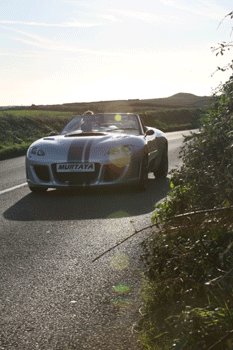
Going, Going, Gone
I knew that this car's capabilities were FAR beyond my
own, and I treated it as such. The enjoyment that I look forward to with my
own Murtaya is learning to tame it and grow into its capabilities. Luckily,
with such a rare and noticeable car, I will also enjoy just driving around in
it and watching people's faces (in fact, just on Neil's and my drive around
Cornwall, we got many waves, looks, and cheers from both pedestrians and
drivers).
Not to say that I never opened it up. I let her
fly a few times (you know, for perfectly valid and legal reasons, like for
passing somebody or outrunning a Russian mafia Formula-1 car that just
happened to be invisible and chasing me). This was one of those cars that you
didn't know just how fast you were going until you looked at the
speedometer...and then looked at it again in disbelief. Yes, you really were
going that fast.
So it was very impressive and enjoyable to drive. However, I
felt bad. Neil and the boys had been so nice and courteous to me (they
had even leant me a beanie to keep my head warm on the drive) and I wanted to
do something nice for them. But what could I offer them? I thought
long and hard on my drive before I thought of it. This was a brand new
transmission, and I could really tell that Neil would have liked it a lot more
if it was "broken in"...
So on my next blast down a straightaway, I
double-clutch downshifted into third, and then - I knew Neil was gonna just love
this - shifted into fourth....but not fully, causing a horrible grinding and
testing the rev limiter once or twice (thought I'd burn the extra carbon outta
those cylinders, also). There, now the transmission had been broken in
properly. No need to thank me, Neil; it's the least I could do.
When we returned, Neil took out my father. Even after
all his years and all the cars he's had, my father was still blown away by the
Murtaya...So much so that you might even be seeing a review from him in the
not-so-distant future...
The day was getting late, and we would say thanks and
goodbye to Neil and the boys until the next day, in which Neil would take us
to Alan Jeffery's Engine Tuner shop, the place that would be tuning my engine...
We met Neil a few miles outside of Plymouth and followed
him all the way to Alan's shop. Inside the shop's main waiting area was a
counter with a rather large portion devoted to pictures of the same Murtaya
that I had driven the day before. And behind the counter, the man himself:
Alan Jeffery. His shop was full of all sorts of cars - everything from a new STi project car to an original Mini to a pristine, original, and imported
Dodge Charger. Alan himself has a 400hp+ Evo.
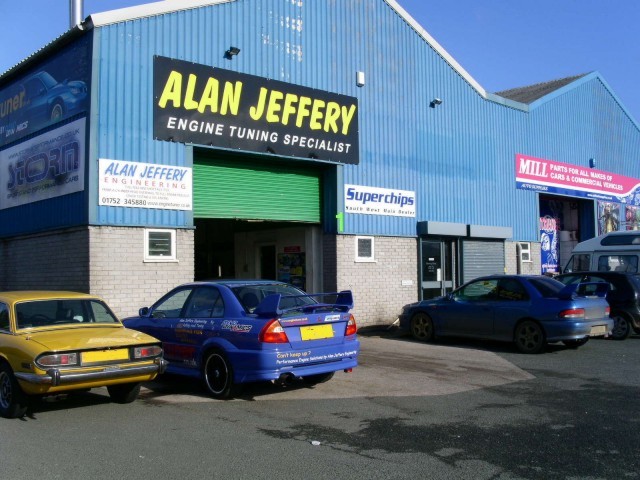
Alan's place and Evo
You could tell that Alan (much like Neil and the guys at
AMS) both knew what he was doing and loved what he was doing. For any
question I had, he would quickly return answers, opinions, and experience.
He took us to the back of the shop where many engine
machining tools lived along with another room that contained an AWD dyno. We
would be seeing an AWD dyno tuning of some WRXs today.
In fact, the first car to be dynode in front of us
belonged to Andy, a friendly and tall bloke (everybody is so tall in England!
Or was it just me?). He had a newer WRX (looked like an '04) which was red
and had all the options (leather seats, sunroof, heated side view mirrors,
etc.) along with a Prodrive rear wing. It was a good looking car, and with
about 366hp (calculated at the crank), it had the guts to go with the looks.
Andy was nice enough to let me go out in his car, and Alan was nice enough to
drive me around in it. Boy did that thing pull! If my Murtaya felt that fast
I would be happy (though with as much power and a third less weight, it should
feel faster, I hope J ).
The next car was a classic style Impreza with too many
mods to list. Unfortunately, it was running very lean during initial pulls.
To make sure that it wasn't the new Simtek engine management causing the lean
runs, the guys quickly replaced the management with the old Apexi unit. The
same thing occurred: not enough fuel. It turns out that the fuel pump would
be the culprit, and a quick fix wouldn't be found that day. Bummer. But
still, it was cool to see the guys at work, the real time data logged from dyno runs, and the quick work that they were able to perform using that
information.
After that, Neil, Alan, and I talked about cars, tuning,
and all sorts of other fun stuff. For the second time in two days, I was
enthralled with the amount of knowledge that people who would be creating
and/or working with the Murtaya had. That, and the fact that they loved to do
it and would probably be doing it even if they weren't getting paid. This is
another one of the great things about this car: it's being put together by
people who truly love what they're doing and love what the car is.
And the car shows. I was originally afraid that this car
would suffer because it is being designed and handmade by a few people rather
than developed and mass produced by a large company. I figured that they
wouldn't have the resources, money, experience, and testing that would exist
with the big company. However, it turns out that the opposite was in fact
true. This car was something that the large car companies could never
produce, and was much better because of it. Neil himself says that he
fears AMS becoming too large of a company.
There's a reason he wants
annual production numbers of the Murtaya to stay below fifty: he wants to meet
and get to know every costumer of AMS, much like he was meeting us that
weekend. But even when considering the Murtaya creation logically: the large companies could never
do the hand process of setting the GRP body. They wouldn't be allowed to make
doors with no handles. They would no doubt fill the car with all sorts of
gadgets that would make it appeal to the broader audience. They would throw
out the incredible rigidity of the car in favor of bigger doors. Odds are
that the AWD might be thrown out because either it wouldn't be "traditional"
or it would weight too much (after all the heavy gadgets and creature comforts
had already been added). Unnecessary, large rear tires would probably be added to make it look
cooler in ads, but at the expense of truly exceptional handling. Also, I wouldn't be
surprised if - being designed by the large companies - the Murtaya would get on
the cycle of more weight, then more weight, then more power, then more weight,
etc. that usually ends up in a two ton car with a lot of (usually unusable)
power but poor handling.
Last - but certainly not least - bean counters and
business managers would ultimately be in charge of the creation, design, and
approval of the car, rather than the people who love to design, create, tune,
and drive it. And this is why - well, at least one reason why - the Murtaya is
such a
very unique and desirable car. A car created by (a term that Neil had
coined) petrosexuals for petrosexuals. A car that is so exciting that it can
bring people from the other side of the world just to test drive it.
And it was definitely worth the trip.
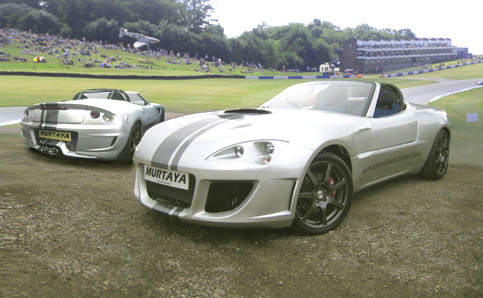
The Murtaya



